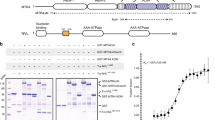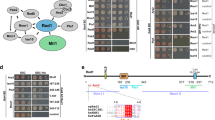Abstract
The conserved Saccharomyces cerevisiae Ski2-like RNA helicase Mtr4p plays essential roles in eukaryotic nuclear RNA processing. RNA helicase activity of Mtr4p is critical for biological functions of the enzyme, but the molecular basis for RNA unwinding is not understood. Here, single-molecule high-resolution optical trapping measurements reveal that Mtr4p unwinds RNA duplexes by 3′-to-5′ translocation on the loading strand, that strand separation occurs in discrete steps of 6 base pairs and that a single Mtr4p molecule performs consecutive unwinding steps. We further show that RNA unwinding by Mtr4p requires interaction with upstream RNA duplex. Inclusion of Mtr4p within the TRAMP complex increases the rate constant for unwinding initiation but does not change the characteristics of Mtr4p's helicase mechanism. Our data indicate that Mtr4p utilizes a previously unknown unwinding mode that combines aspects of canonical translocating helicases and non-canonical duplex-sensing helicases, thereby restricting directional translocation to duplex regions.
This is a preview of subscription content, access via your institution
Access options
Subscribe to this journal
Receive 12 print issues and online access
$259.00 per year
only $21.58 per issue
Buy this article
- Purchase on Springer Link
- Instant access to full article PDF
Prices may be subject to local taxes which are calculated during checkout





Similar content being viewed by others
Accession codes
References
Schneider, C. & Tollervey, D. Threading the barrel of the RNA exosome. Trends Biochem. Sci. 38, 485–493 (2013).
Anderson, J.T. & Wang, X. Nuclear RNA surveillance: no sign of substrates tailing off. Crit. Rev. Biochem. Mol. Biol. 44, 16–24 (2009).
Bernstein, J., Patterson, D.N., Wilson, G.M. & Toth, E.A. Characterization of the essential activities of Saccharomyces cerevisiae Mtr4p, a 3′>5′ helicase partner of the nuclear exosome. J. Biol. Chem. 283, 4930–4942 (2008).
Schmidt, K. & Butler, J.S. Nuclear RNA surveillance: role of TRAMP in controlling exosome specificity. Wiley Interdiscip. Rev. RNA 4, 217–231 (2013).
Bernstein, J. & Toth, E.A. Yeast nuclear RNA processing. World J. Biol. Chem. 3, 7–26 (2012).
de la Cruz, J., Kressler, D., Tollervey, D. & Linder, P. Dob1p (Mtr4p) is a putative ATP-dependent RNA helicase required for the 3′ end formation of 5.8S rRNA in Saccharomyces cerevisiae. EMBO J. 17, 1128–1140 (1998).
Sloan, K.E., Bohnsack, M.T., Schneider, C. & Watkins, N.J. The roles of SSU processome components and surveillance factors in the initial processing of human ribosomal RNA. RNA 20, 540–550 (2014).
van Hoof, A., Lennertz, P. & Parker, R. Yeast exosome mutants accumulate 3′-extended polyadenylated forms of U4 small nuclear RNA and small nucleolar RNAs. Mol. Cell. Biol. 20, 441–452 (2000).
Wang, X., Jia, H., Jankowsky, E. & Anderson, J.T. Degradation of hypomodified tRNA(iMet) in vivo involves RNA-dependent ATPase activity of the DExH helicase Mtr4p. RNA 14, 107–116 (2008).
Jia, H. et al. The RNA helicase Mtr4p modulates polyadenylation in the TRAMP complex. Cell 145, 890–901 (2011).
Vanácová, S. et al. A new yeast poly(A) polymerase complex involved in RNA quality control. PLoS Biol. 3, e189 (2005).
LaCava, J. et al. RNA degradation by the exosome is promoted by a nuclear polyadenylation complex. Cell 121, 713–724 (2005).
Callahan, K.P. & Butler, J.S. TRAMP complex enhances RNA degradation by the nuclear exosome component Rrp6. J. Biol. Chem. 285, 3540–3547 (2010).
Jia, H., Wang, X., Anderson, J.T. & Jankowsky, E. RNA unwinding by the Trf4/Air2/Mtr4 polyadenylation (TRAMP) complex. Proc. Natl. Acad. Sci. USA 109, 7292–7297 (2012).
Johnson, S.J. & Jackson, R.N. Ski2-like RNA helicase structures: common themes and complex assemblies. RNA Biol. 10, 33–43 (2013).
Taylor, L.L. et al. The Mtr4 ratchet helix and arch domain both function to promote RNA unwinding. Nucleic Acids Res. 42, 13861–13872 (2014).
Lange, H., Sement, F.M. & Gagliardi, D. MTR4, a putative RNA helicase and exosome co-factor, is required for proper rRNA biogenesis and development in Arabidopsis thaliana. Plant J. 68, 51–63 (2011).
Li, Y., Burclaff, J. & Anderson, J.T. Mutations in Mtr4 structural domains reveal their important role in regulating tRNAiMet turnover in Saccharomyces cerevisiae and Mtr4p enzymatic activities in vitro. PLoS One 11, e0148090 (2016).
Lubas, M. et al. Interaction profiling identifies the human nuclear exosome targeting complex. Mol. Cell 43, 624–637 (2011).
Anderson, J.S. & Parker, R.P. The 3′ to 5′ degradation of yeast mRNAs is a general mechanism for mRNA turnover that requires the SKI2 DEVH box protein and 3′ to 5′ exonucleases of the exosome complex. EMBO J. 17, 1497–1506 (1998).
Jarmoskaite, I. & Russell, R. RNA helicase proteins as chaperones and remodelers. Annu. Rev. Biochem. 83, 697–725 (2014).
Staley, J.P. & Guthrie, C. Mechanical devices of the spliceosome: motors, clocks, springs, and things. Cell 92, 315–326 (1998).
Büttner, K., Nehring, S. & Hopfner, K.P. Structural basis for DNA duplex separation by a superfamily-2 helicase. Nat. Struct. Mol. Biol. 14, 647–652 (2007).
Jackson, R.N. et al. The crystal structure of Mtr4 reveals a novel arch domain required for rRNA processing. EMBO J. 29, 2205–2216 (2010).
Weir, J.R., Bonneau, F., Hentschel, J. & Conti, E. Structural analysis reveals the characteristic features of Mtr4, a DExH helicase involved in nuclear RNA processing and surveillance. Proc. Natl. Acad. Sci. USA 107, 12139–12144 (2010).
Pyle, A.M. Translocation and unwinding mechanisms of RNA and DNA helicases. Annu. Rev. Biophys. 37, 317–336 (2008).
Singleton, M.R., Dillingham, M.S. & Wigley, D.B. Structure and mechanism of helicases and nucleic acid translocases. Annu. Rev. Biochem. 76, 23–50 (2007).
Yang, Q. & Jankowsky, E. The DEAD-box protein Ded1 unwinds RNA duplexes by a mode distinct from translocating helicases. Nat. Struct. Mol. Biol. 13, 981–986 (2006).
Yang, Q., Del Campo, M., Lambowitz, A.M. & Jankowsky, E. DEAD-box proteins unwind duplexes by local strand separation. Mol. Cell 28, 253–263 (2007).
Linder, P. & Jankowsky, E. From unwinding to clamping - the DEAD box RNA helicase family. Nat. Rev. Mol. Cell Biol. 12, 505–516 (2011).
Comstock, M.J., Ha, T. & Chemla, Y.R. Ultrahigh-resolution optical trap with single-fluorophore sensitivity. Nat. Methods 8, 335–340 (2011).
Comstock, M.J. et al. Protein structure. Direct observation of structure-function relationship in a nucleic acid-processing enzyme. Science 348, 352–354 (2015).
Dumont, S. et al. RNA translocation and unwinding mechanism of HCV NS3 helicase and its coordination by ATP. Nature 439, 105–108 (2006).
Qu, X., Lancaster, L., Noller, H.F., Bustamante, C. & Tinoco, I. Jr. Ribosomal protein S1 unwinds double-stranded RNA in multiple steps. Proc. Natl. Acad. Sci. USA 109, 14458–14463 (2012).
Bustamante, C., Chemla, Y.R., Forde, N.R. & Izhaky, D. Mechanical processes in biochemistry. Annu. Rev. Biochem. 73, 705–748 (2004).
Putnam, A.A. & Jankowsky, E. DEAD-box helicases as integrators of RNA, nucleotide and protein binding. Biochim. Biophys. Acta 1829, 884–893 (2013).
Tinoco, I. Jr., Collin, D. & Li, P.T. The effect of force on thermodynamics and kinetics: unfolding single RNA molecules. Biochem. Soc. Trans. 32, 757–760 (2004).
Cisse, I.I., Kim, H. & Ha, T. A rule of seven in Watson-Crick base-pairing of mismatched sequences. Nat. Struct. Mol. Biol. 19, 623–627 (2012).
Greenleaf, W.J., Frieda, K.L., Foster, D.A., Woodside, M.T. & Block, S.M. Direct observation of hierarchical folding in single riboswitch aptamers. Science 319, 630–633 (2008).
Jankowsky, E., Gross, C.H., Shuman, S. & Pyle, A.M. The DExH protein NPH-II is a processive and directional motor for unwinding RNA. Nature 403, 447–451 (2000).
Kawaoka, J., Jankowsky, E. & Pyle, A.M. Backbone tracking by the SF2 helicase NPH-II. Nat. Struct. Mol. Biol. 11, 526–530 (2004).
Beran, R.K., Bruno, M.M., Bowers, H.A., Jankowsky, E. & Pyle, A.M. Robust translocation along a molecular monorail: the NS3 helicase from hepatitis C virus traverses unusually large disruptions in its track. J. Mol. Biol. 358, 974–982 (2006).
Cheng, W., Arunajadai, S.G., Moffitt, J.R., Tinoco, I. Jr. & Bustamante, C. Single-base pair unwinding and asynchronous RNA release by the hepatitis C virus NS3 helicase. Science 333, 1746–1749 (2011).
Liu, S. et al. A viral packaging motor varies its DNA rotation and step size to preserve subunit coordination as the capsid fills. Cell 157, 702–713 (2014).
Johnson, D.S., Bai, L., Smith, B.Y., Patel, S.S. & Wang, M.D. Single-molecule studies reveal dynamics of DNA unwinding by the ring-shaped T7 helicase. Cell 129, 1299–1309 (2007).
Qi, Z., Pugh, R.A., Spies, M. & Chemla, Y.R. Sequence-dependent base pair stepping dynamics in XPD helicase unwinding. eLife 2, e00334 (2013).
Houseley, J. & Tollervey, D. The many pathways of RNA degradation. Cell 136, 763–776 (2009).
Thoms, M. et al. The exosome is recruited to RNA substrates through specific adaptor proteins. Cell 162, 1029–1038 (2015).
Landry, M.P., McCall, P.M., Qi, Z. & Chemla, Y.R. Characterization of photoactivated singlet oxygen damage in single-molecule optical trap experiments. Biophys. J. 97, 2128–2136 (2009).
Acknowledgements
We thank members of the Comstock and Jankowsky laboratories for scientific discussion. Funding was provided by US National Science Foundation grant MCB-1514706 (to M.J.C.) and US National Institutes of Health grants R01 GM118088 and GM099720 (to E.J.).
Author information
Authors and Affiliations
Contributions
M.J.C., E.J. and E.M.P. conceived and designed the high-resolution single-molecule trapping experiments. E.M.P. produced tether constructs and performed all single-molecule experiments. E.M.P. and M.J.C. performed single-molecule data analysis. S.S. produced Mtr4p and TRAMP samples and performed all ensemble experiments and data analysis. E.M.P., S.S., E.J. and M.J.C. wrote the paper.
Corresponding author
Ethics declarations
Competing interests
The authors declare no competing financial interests.
Supplementary information
Supplementary Text and Figures
Supplementary Results and Supplementary Figures 1–9. (PDF 1314 kb)
Rights and permissions
About this article
Cite this article
Patrick, E., Srinivasan, S., Jankowsky, E. et al. The RNA helicase Mtr4p is a duplex-sensing translocase. Nat Chem Biol 13, 99–104 (2017). https://doi.org/10.1038/nchembio.2234
Received:
Accepted:
Published:
Issue Date:
DOI: https://doi.org/10.1038/nchembio.2234
This article is cited by
-
Cellular functions of eukaryotic RNA helicases and their links to human diseases
Nature Reviews Molecular Cell Biology (2023)
-
Observation of processive telomerase catalysis using high-resolution optical tweezers
Nature Chemical Biology (2020)



